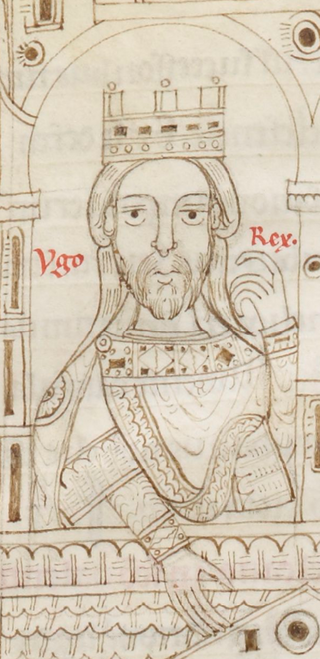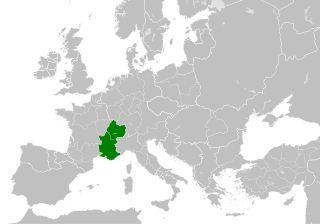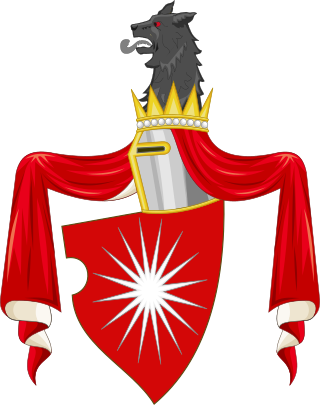
Hugh, known as Hugh of Arles or Hugh of Provence, was the king of Italy from 926 until his death. He belonged to the Bosonid family. During his reign, he empowered his relatives at the expense of the aristocracy and tried to establish a relationship with the Byzantine Empire. He had success in defending the realm from external enemies, but his domestic habits and policies created many internal foes and he was removed from power before his death.

The Kingdom of Burgundy, known from the 12th century as the Kingdom of Arles, also referred to in various context as Arelat, the Kingdom of Arles and Vienne, or Kingdom of Burgundy-Provence, was a realm established in 933 by the merger of the kingdoms of Upper and Lower Burgundy under King Rudolf II. It was incorporated into the Holy Roman Empire in 1033 and from then on was one of the empire's three constituent realms, together with the Kingdom of Germany and the Kingdom of Italy. By the mid-13th century at the latest, however, it had lost its concrete political relevance.

The Archdiocese of Lyon, formerly the Archdiocese of Lyon–Vienne–Embrun, is a Latin Church metropolitan archdiocese of the Catholic Church in France. The archbishops of Lyon are also called primates of Gaul. An archbishop is usually elevated by the pope to the rank of cardinal.

The Archdiocese of Aix-en-Provence and Arles is a Latin Church ecclesiastical territory or archdiocese of the Catholic Church in France. The archepiscopal see is located in the city of Aix-en-Provence. The diocese comprises the department of Bouches-du-Rhône, in the Region of Provence-Alpes-Côte d'Azur. It is currently a suffragan of the Archdiocese of Marseilles and consequently the archbishop no longer wears the pallium.
The Archbishopric of Vienne, named after its episcopal seat in Vienne in the Isère département of southern France, was a metropolitan Roman Catholic archdiocese. It is now part of the Archdiocese of Lyon.

The Diocese of Vaison was a Roman Catholic diocese in France, suppressed in 1801, with its territory transferred to the Diocese of Avignon. It had been one of nine dioceses in the ecclesiastical province presided over by the archbishop of Arles, but a later reorganization placed Vasio, i.e. today's Vaison-la-Romaine, under the archbishop of Avignon. Jurisdiction inside the diocese was shared between the bishop and the Comte de Provence, higher justice and the castle belonging to the Comte, and civil justice and all other rights belonging to the bishop. The cathedral was served by a chapter which had four dignities: the provost (praepositus), the archdeacon, the sacristan, and the precentor. There were also six canons, each of whom had a prebend attached to his office.

The House of Baux is a French noble family from the south of France. It was one of the richest and most powerful families of medieval Provence, known as the 'Race d’Aiglon'. They were independent lords as castellans of Les Baux and Arles and wielded very considerable authority at the local level. They held important fiefs and vast lands, including the principality of Orange.

The Diocese of Valence (–Die–Saint-Paul-Trois-Châteaux) (Latin: Dioecesis Valentinensis ; French: Diocèse de Valence is a Latin Church diocese of the Catholic Church in southern France. The contemporary diocese is co-extensive with the department of Drôme.

The Diocese of Le Puy-en-Velay is a Latin diocese of the Catholic Church in France. The diocese comprises the whole Department of Haute-Loire, in the Region of Auvergne-Rhône-Alpes.

The former French Roman Catholic diocese of Agde existed from about the 6th century to the Concordat of 1801 between First Consul Napoleon Bonaparte and Pope Pius VII. Agde is in the south of France, in what is now the department of Hérault. The last bishop, Charles François de Rouvroy de Saint Simon Sandricourt, was guillotined in Paris on July 25, 1794.

The former French Roman Catholic Diocese of Saint-Paul-Trois-Châteaux, sometimes, just like the town, also known as the Diocese of Saint-Paul-en-Tricastin, existed from the sixth century to the French Revolution.

The former French Catholic diocese of Die existed from the fourth to the thirteenth century, and then again from 1678 to the French Revolution. It was suppressed by the Concordat of 1801, its territory being assigned to the diocese of Grenoble. The seat of the bishop was located in the Cathedral of the Assumption in Die.
Richard de Millau (Milhau) was an 11th-century Cardinal and a major player in the Gregorian reform implemented in the South of France at the turn of the eleventh and twelfth centuries.
The army of Raymond of Saint-Gilles was one of the first to be formed after Pope Urban II called for the First Crusade. Raymond formed a Provençal army and left his County of Toulouse in October 1096, traveling over the land route. He was the only leader of a major army that did not swear an oath of fealty to Byzantine emperor Alexius I Komnenos.

The Abbey of St Caesarius, at first called the abbey or monastery of St John, was a nunnery in the city of Arles in the south-eastern corner of the rampart. It was founded in 512 AD by Saint Caesarius of Arles, after whom it is now named. The abbey was suppressed in the French Revolution. Those that remained of the buildings were later used as a hospice; they are now adandoned.
Rostang of Arles was Archbishop of Arles from 870 to 913. He supported the coup d'état of Boso of Provence against the Carolingians in 879.
Teucinde of Arles was a Burgundian aristocrat who lived in Arles, Provence, and was known for her numerous donations to the Arles Church.

Laugier of Nice, known as the Roux, is also known as Laugier of Orange-Mévouillon or Laugier of Vence. He was co-lord of Nice, Gréolières, Cagnes and Vence. He held these titles in part through his wife Odile of Provence and his father-in-law, William I of Provence. Laugier seems to be related to the Mévouillon-Orange lineage. Some historians give him the title of viscount. He was a member of the first house of the counts of Orange-Nice. From 1023 Laugier was a monk of the order of Cluny.

Noël Coulet was a French academic and medieval historian.